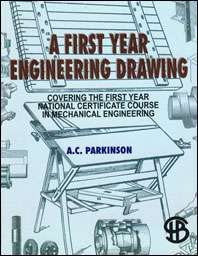Description
First Year Engineering Drawing
| Author | : A.C. Parkinson |
| Year | : 2006 |
| BookType | : Paperback |
| Pages | : 190 |
| ISBN | : 9788175980624 |
First Year Engineering Drawing (English) by A.C. Parkinson
Description
First Year Engineering Drawing
In this course of his training in engineering drawing the student should gain and develop.
- A clear conception and appreciation of form, proportion, and purpose.
- Speed and accuracy in the use of pencil and drawing instruments.
- The ability to think in three dimensions.
- The power of expressing his ideas in construction work quickly and clearly by freehand sketches.
- Competency in original design.
The very encouraging reception accorded to my book, Engineering Workshop Drawing, has emboldened the production of this volume covering a somewhat extended field in engineering drawing, and arranged so as to be sufficient in scope and standard to meet the requirements in machine drawing of the first-year course for the National Certificate in mechanical engineering, as well as to cover the usual Technical School and Matriculation syllabuses. The number of students who commence part-time engineering courses with little or no previous formal training in engineering drawing is not inconsiderable. The greater number of these, too, are drawn from workshops where in the very nature of things they are entering into relationship with the things of practical significance a relationship which too often provokes an impatience with a disciplinary course and a desire for the immediate interpretation of educational values in terms of direct utility.
Experience shows that the surest progress is made by those who have received the soundest preliminary training in the principles of plane and solid geometry, and, whilst the exigencies of space preclude a liberal treatment of those subjects in the present volume, an attempt has been made to link up important geometrical constructions with practical applications. This, of course, can readily be amplified by the teacher according to the requirements and the capacity of his students and the nature of the syllabus.
Thoughtless empiricism in the early stages of engineering drawing provides a most unsatisfactory foundation. In this, as in every branch of educational endeavour, satisfactory progress can only result from disciplined step by step purpose in conquering principles as well as processes. It naturally follows that the best test of the teaching of the subject is the extent to which it evokes this purpose and excites activity in its attainment.
Numerous recent examination examples, orthographic and pictorial, are provided. These should save a busy teacher many hours of profitless time expended in the production of elaborate blackboard diagrams or duplicator stencils. The questions serve, also, to get the students into the examination stride.
Thanks are accorded to the following examination bodies for ready and courteous permission to reprint questions from their examination papers: Northern Counties Technical Examinations Council, Royal Society of Arts, Union of Educational Institutions, City and Guilds of London Institute, University of London, H.M. Stationery Office, and Surrey Education Committee.
Thanks are also due to the British Standards Institution for permission to reprint or abstract particulars from British Standard No. 308 official copies of which can be obtained from the Director of the Institution, 2 Park Street, London, W.I.
Finally, I have the happy privilege of thanking Mr. J. H. Currie for his timely and valuable Foreword on the teaching of the subject.
It is probably a vain hope that a book containing so many hundreds of dimensions is entirely free from errors, and I shall be glad if any such are pointed out to me. A. C. Parkinson












Reviews
There are no reviews yet.